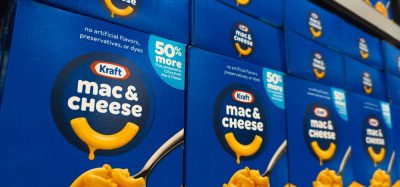Selection of starters for flavour formation in dairy foods
- Like
- Digg
- Del
- Tumblr
- VKontakte
- Buffer
- Love This
- Odnoklassniki
- Meneame
- Blogger
- Amazon
- Yahoo Mail
- Gmail
- AOL
- Newsvine
- HackerNews
- Evernote
- MySpace
- Mail.ru
- Viadeo
- Line
- Comments
- Yummly
- SMS
- Viber
- Telegram
- Subscribe
- Skype
- Facebook Messenger
- Kakao
- LiveJournal
- Yammer
- Edgar
- Fintel
- Mix
- Instapaper
- Copy Link
Posted: 1 May 2014 | Wim J.M. Engels, Senior Project Manager and Scientist, NIZO food research | No comments yet
Fermented low salt and low fat dairy foods, such as cheese and yoghurt, with great taste – this is possible with the rational design of improved, tailor-made industrial cultures with attractive flavour forming properties. Various tools and model systems for directed screening for flavour producing (starter) organisms are now available for enabling successful selection of strains.


Wim J.M. Engels, Senior Project Manager and Scientist, NIZO food research
In recent years, consumer awareness of healthy diet choices has created a trend towards low fat and low salt foods. This trend is a major challenge for the industry, most notably concerning sensory quality, but it also opens up great possibilities since challenges can be tackled by targeted fermentation. The natural biodiversity which exists in dairy starter organisms offers new possibilities when explored and applied in practice. Key to the consumer acceptability and thus the success of low salt and low fat varieties of, for example, cheese is the flavour quality. Low fat and low salt foods are often sensorially scored as bland and lacking flavour, but can also be high in undesired flavours such as bitterness. In fermented food products such as cheese and yoghurt, many flavour / aroma molecules can be found1,2. Examples are shown in Table 1. For tailoring the flavour of (fermented) food products, it is highly important to recognise which of these flavour compounds are determining the overall quality the most (so-called key-flavour or keyaroma compounds).
The understanding of flavour formation processes and pathways in full fat as well as in low fat fermented foods variants has facilitated innovation in this field. The development of high throughput screening methods in combination with the availability of large culture collections has allowed for the screening and selection of novel starter cultures for dairy foods such as cheese1.
Formation of flavour compounds during dairy fermentation
The main purpose of applying fermentation in foods is to ensure a proper preservation of the fermented product. In cheese and yoghurt, the rapid conversion of lactose, present in milk, into lactic acid is the most important feature of lactic acid bacteria in this respect. The resulting reduction of pH, removal of oxygen and the absence of lactose inhibits the growth of undesired bacteria. In addition to the production of lactic acid, organisms used in fermented dairy products also determine the flavour of the product. Milk is a rather bland product with regard to its flavour. This means that in fermented dairy products, the flavour compounds are nearly all generated during the fermentation and ripening of the product. Flavour development in fermented dairy products is a complex and, in the case of cheese ripening, slow process involving chemical and biochemical conversions of milk components1,3. The two main events during cheese maturation, largely following the fast fermentation of lactose, are proteolysis followed by amino acid degradation and conversion of fat.
In cheese, the activities of rennet enzymes and proteolytic enzymes from lactic acid bacteria (LAB) yield small peptides and free amino acids from casein. In yoghurt, no rennet is applied and the LAB (S. thermophilus and L. bulgaricus) here closely cooperate to liberate the amino acids necessary for growth from the proteins in their environment. The small peptides and amino acids are responsible for the background flavours in a matured cheese, e.g. savoury, brothy, sweet and salty, but can also deliver (undesired) bitter flavours4,5. Further specific development of cheese flavour results from amino acid conversion yielding various alcohols, aldehydes, acids, esters and sulphur compounds1,3. Yoghurt flavour is generally mild and is formed by a combination of lactic acid and various carbonyl compounds like acetaldehyde, from threonine, and diacetyl6.
A general overview of protein and following amino acid conversion pathways relevant for flavour formation in cheese are shown in Figure 1.
The most important flavour compounds originating from fat are free fatty acids produced by lipolysis. Lactic acid bacteria usually possess relatively weak lipolytic activities. Generally, Italian, Blue and certain mould- and smear-ripened types undergo extensive lipolysis, while Cheddar and Dutch-type cheeses and yoghurt undergo relatively low levels of lipolysis7. Fatty acids have flavour notes ranging from pungent-sharp via soapy-rancid to waxy and sometimes even bitter. In cheese, free fatty acids are precursors of many important flavour compounds, such as methyl ketones, lactones, esters, aldehydes and secondary alcohols. These compounds have musty, fruity, floral and spicy notes.
Lowering salt and fat
As explained above, fat will play an essential direct role in flavour perception since it is a precursor of flavour compounds. The altered levels of formation of fat derived compounds will thus be a cause of the changed perception of flavour. However, fat also plays an essential role in the texture of foods and in flavour release8. The latter role is, in part, an indirect one by influencing the distribution over the fat and aqueous phases of especially (volatile) aroma compounds. Reduction of the fat content may consequently result in much less satisfactory flavour perception, as a result of flavour (release) imbalance. Figure 2 exemplifies the principle of altered flavour compound release when lowering fat in yoghurt.
Also lowering the NaCl concentration in food products, such as cheese, without changing consumer acceptability is a major challenge for the food industry. It is recognised that the role of NaCl in cheese is more than that of direct flavour compound. Texture formation, growth, metabolism and survival of microorganisms as well as aroma release and perception are influenced too. Among others, the growth (and lysis) of desired starter and non-starter lactic acid bacteria are controlled by the NaCl concentration in cheese. This NaCl-effect has major consequences for flavour forming enzymes and reactions, for example, and consequently the ultimate (flavour) quality of the cheese. Lowering the NaCl concentration may hence result in unbalanced flavour formation. The effect of salt on processes that are important for formation of flavour compounds during ripening however reflects only part of its role in cheese. Sodium chloride has a highly appreciated taste itself and is also an important enhancer of other taste or aroma active compounds. For these reasons, the flavour of NaCl-free cheese is often described as ‘insipid’ and ‘watery’9.
Tailoring flavour formation by selection of cultures
A feasible approach to counteract loss or alteration of flavour due to lowered fat and/or salt levels is by adapting and tailoring the formation of key compounds to such an extent that restoration and/or compensation of flavour is reached. Examples of (non-volatile) compounds that may influence salty flavour perception are certain amino acids, peptides or for example succinic acid that generally exert congruent flavours and/or flavour enhancement (Table 2). However, volatile flavour compounds have also been shown to effect salty flavour perception10.
In low fat products, optimisation of (fermentative) volatile flavour compound formation may be a feasible approach for repair of the flavour (release) balance. To tailor release profiles, insight in differences in liberation of flavour compounds during consumption in vivo of full-fat and low fat foods is essential (for instance using MS-nose studies as described above) as well as options to mimic desired optimal flavour release profiles (e.g. by using an olfactometer). The latter enables simulation of the sensorial experience of a full-fat food by controlled dosage of key compounds13. Figure 3 shows principle tools applied nowadays and exemplifies improvement of the flavour balance of a low fat product by optimisation of the aroma compound composition. The starter microorganisms are the main instrument for this optimisation and the large natural biodiversity which exists in starter microorganisms, e.g. Lactococcus lactis, Lactobacillus and Streptococcus thermophilus, offers exiting possibilities when explored and applied in practice for reaching restoration of flavour.
Application of selected (adjunct) strains during cheese production will yield desired volatile and non-volatile compounds. Consequently, high-performing starter cultures can be developed by careful selection and combination of strains with desired enzyme activities1. Recent technological innovations in the field of automated screening make the extensive screening of strains possible that is required for effective culture selection. A high throughput MicroCheese model, described by Bachmann et al14, was developed at NIZO food research (Figure 4). This model allows the simultaneous manufacturing of hundreds individual real cheeses in microtitre plate format, hence enabling reliable prediction of culture performance, e.g. for compensating for flavour defects in low fat / salt cheese. Protocols for various types of cheese and dedicated MicroCheese analysis tools are available. In addition to this cheese screening system, yoghurt model systems are available for directed in-product screening for suitable flavour producing (starter) organisms in, for example, low fat yoghurt.
References
- Smit, G, Smit, BA, Engels, WJM (2005) Flavour formation by lactic acid bacteria and biochemical flavour profiling of cheese products. FEMS Microbiology Reviews, 29(3), 591-610
- Engels, WJM, Wouters, JA (2013) New developments for selection of starters for flavour formation in cheese. In: Cheese Ripening: Quality, Safety and Health Aspects. Editors: Cinzia Lucia Randazzo, Cinzia Caggia and Erasmo Neviani, Nova, NY, 97-114
- Ziadi, M, Bergot, G, Courtin, P, Chambellon, E, Hamdi, M, Yvon, M. (2010) Amino acid catabolism by Lactococcus lactis during milk fermentation. International Dairy Journal, 20(1), 25-31
- Engels, WJM, Visser, S (1994) Isolation and comparative characterisation of components that contribute to the flavour of different types of cheese. Netherlands Milk and Dairy Journal, 48, 127-140
- Toelstede, S, Hofmann, T (2008) Sensomics Mapping and Identification of the Key Bitter Metabolites in Gouda Cheese. Journal of Agricultural and Food Chemistry, 56, 2795–2804
- Cheng, H (2010) Volatile flavor compounds in yogurt: a review. Crit Rev Food Sci Nutr. 50(10):938-50
- McSweeney, PLH (2004) Biochemistry of cheese ripening. International Journal of Dairy Technology, 57(2/3), 127–144
- Van de Velde, F, De Hoog, EHA, Ruijschop, RMAJ (2008) Sensory perception of emulsions: translating science into products. AgroFOOD industry hi-tech 19 (May/June) 50-52
- Guinee, T, Fox, P F (2004) Salt in cheese: Physical, chemical and biological aspects, In: ‘Cheese Chemistry, Physics and Microbiology, General Aspect’, 3rd edn, Vol. 1, (eds P. F. Fox, P. McSweeney, T. Cogan and T. Guinee), Elsevier Academic Press, Amsterdam. pp. 207-259
- Knoop, J (2011) Cross-modal interactions in complex food matrices. PhD thesis Wageningen University
- Drake, SL, Carunchia Whetstine, ME, Drake, MA, Courtney, P, Fligner, K, Jenkins, J, Pruitt, C (2007) Sources of Umami Taste in Cheddar and Swiss Cheeses. Journal of food science, 72:S360-366
- Toelstede, S, Hofmann, T (2009) Kokumi-Active Glutamyl Peptides in Cheeses and Their Biogeneration by Penicillium roquefortii. J. Agric. Food Chem., 57, 3738–3748
- de Kok, PMT, Boelrijk, AEM, de Jong, C, Burgering, MJM, Jacobs, MA (2006) MS-NOSE Flavour release profile mimic, using an olfactometer In: Developments in food science 43; Flavour Science, Recent Advances and Trends, Edited by:W. Bredie and M.A. Petersen, Roskilde, Denmark, pp 585-599
- Bachmann, H, Kruijswijk, Z, Molenaar, D, Kleerebezem, M, van Hylckama Vlieg, JET (2009) A high-throughput cheese manufacturing model for effective cheese starter culture screening. Journal of Dairy Science,92(12), 5868-5882
About the author
Dr Wim J. M. Engels is a Senior Project Manager and Scientist at NIZO food research. He has over 20 years of experience in food (bio)chemistry, microbiology and analytics and specialises in food fermentations and flavour formation processes in dairy foods. His current research focuses on tailoring of flavour balance for improvement of fermented foods.









